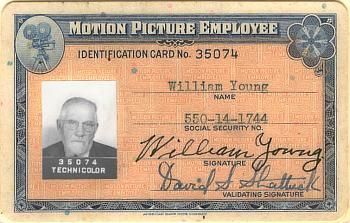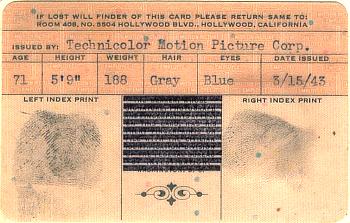Technicolor History 4 (original) (raw)
Technicolor, and all competitive color processes, were notoriously "slow". Tremendous amounts of light were required to properly expose color films in the 20's through the 50's. This is a photo of Technicolor meter #27, calibrated in HUNDREDS of footcandles. The meter was manufactured by General Electric. Courtesy of John N. Whittle
The fact that the vast majority of "natural" color processes were two-color does not indicate that film makers and technicians were ignorant of color and what was necessary to present a full palette. Rather it indicates that doing more than two colors was substantially more difficult and the technology was not of sufficient quality to make the considerable extra cost worthwhile. One requisite of any color system that strived for wide appeal was that it had to be a subtractive color process that yielded a strip of film that could be run in the same projectors as conventional black and white film. It was difficult enough to place one color on each side of the film, but there wasn't a third side to accept a blue record, so compromises were made in the form of two-color systems that needed red and green and could fudge a bit on the blue. But even though Hollywood film makers felt that the latest two color version of Technicolor was adequate, and it had provided benefits at the box office, ultimately the film going audience became underwhelmed with color.
But Dr. Kalmus and his staff had developed a reliable method that allowed color records to be placed on top of each other, in the form of dye transfer printing, and thus any number of color records could be applied to one side of the film base. (Competitive systems such as Cinecolor and several others continued to print color records to both sides of the film base into the early 1950s.)
In 1931 Kalmus put the company on the course to develop a three strip camera and to refine the dye transfer printing that had been introduced in 1927. In 1932 the first camera was completed, and it was expensive, costing in excess of 30,000duringatimewhentheaverageAmericanwagewaslessthan30,000 during a time when the average American wage was less than 30,000duringatimewhentheaverageAmericanwagewaslessthan.50 per hour.
Many accolades have been put on Dr. Kalmus, but one seldom given would be of salesman extraordinaire. Since its founding in 1915, the company had not earned a profit more than one or two years. Yet he was able, time and again, to approach the stockholders for more money to do the work he felt necessary. In 1932 his perseverance was about to pay off. As studios were almost totally abandoning the production of color films, or even inserts, Kalmus was about to shake them up once again.
At Left - Half of the magic behind GLORIOUS TECHNICOLOR, the venerable 3-strip camera. The film magazine held three reels of specially prepared black and white film. The operation of the 3-strip camera is discussed a bit later. For over 20 years, every color system that was developed, and there were hundreds of them, measured their quality against this machine, and virtually all were patently inferior.
Technicolor had been researching and testing three strip printing for several years and the Doctor felt that the system was ready to be unveiled.
The Man Who Hand Built The First Three-Strip Camera


His name was William Young. He was born in 1871 in Springfield, Illinois, of Scottish immigrant parents. William was a machinist foreman for the Wabash Railroad and Sangamo Electric in Springfield before moving to California around 1917 where he ran his own machine shop before joining Technicolor in 1920. His great-granddaughter, Susan Smith, tells us a bit about William Young: "He worked closely with Natalie Kalmus (at least at first). According to my aunt (still living) he spoke very highly of Natalie and liked her very much. According to my aunt, my great-grandfather was given the plan drawings on Technicolor's 3-color camera & asked if he could build it - he, of course, did build it. It was an accomplishment that he was very proud of. My aunt was a young teenager when Becky Sharp was finished and even though the movie was an inappropriate subject for someone of her age, my great-grandfather insisted that she attend the showing 'to see the new color'. Technicolor treated my great-grandfather very good - in later years, as his eyesight started to fail and he could not do the detailed work any longer, they still kept him busy working in the company until his retirement in 1947 at the age of 76."
Young was 60 years old when he built that first camera. Shown above, front and back, is his wartime I.D. card, issued when he was 71 years of age. The man who had built the first Technicolor 3-strip camera passed away on March 3, 1951.